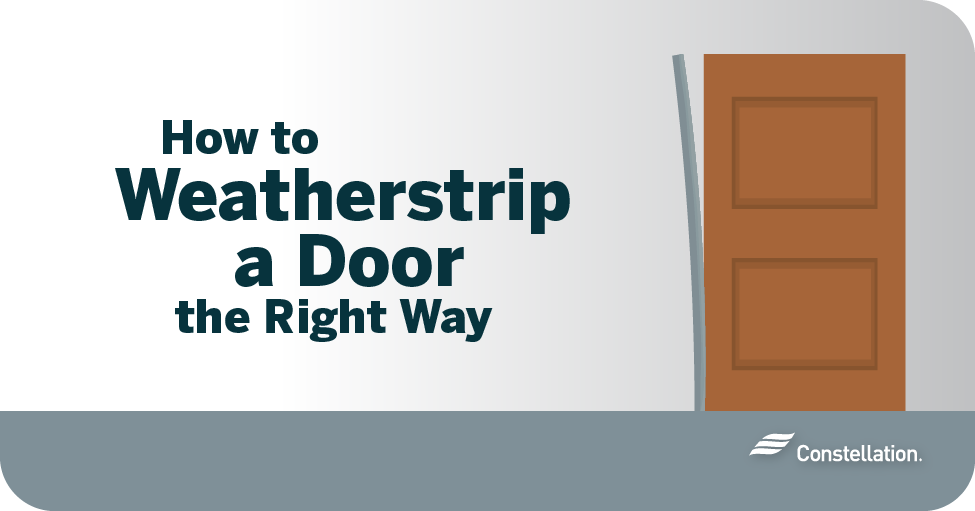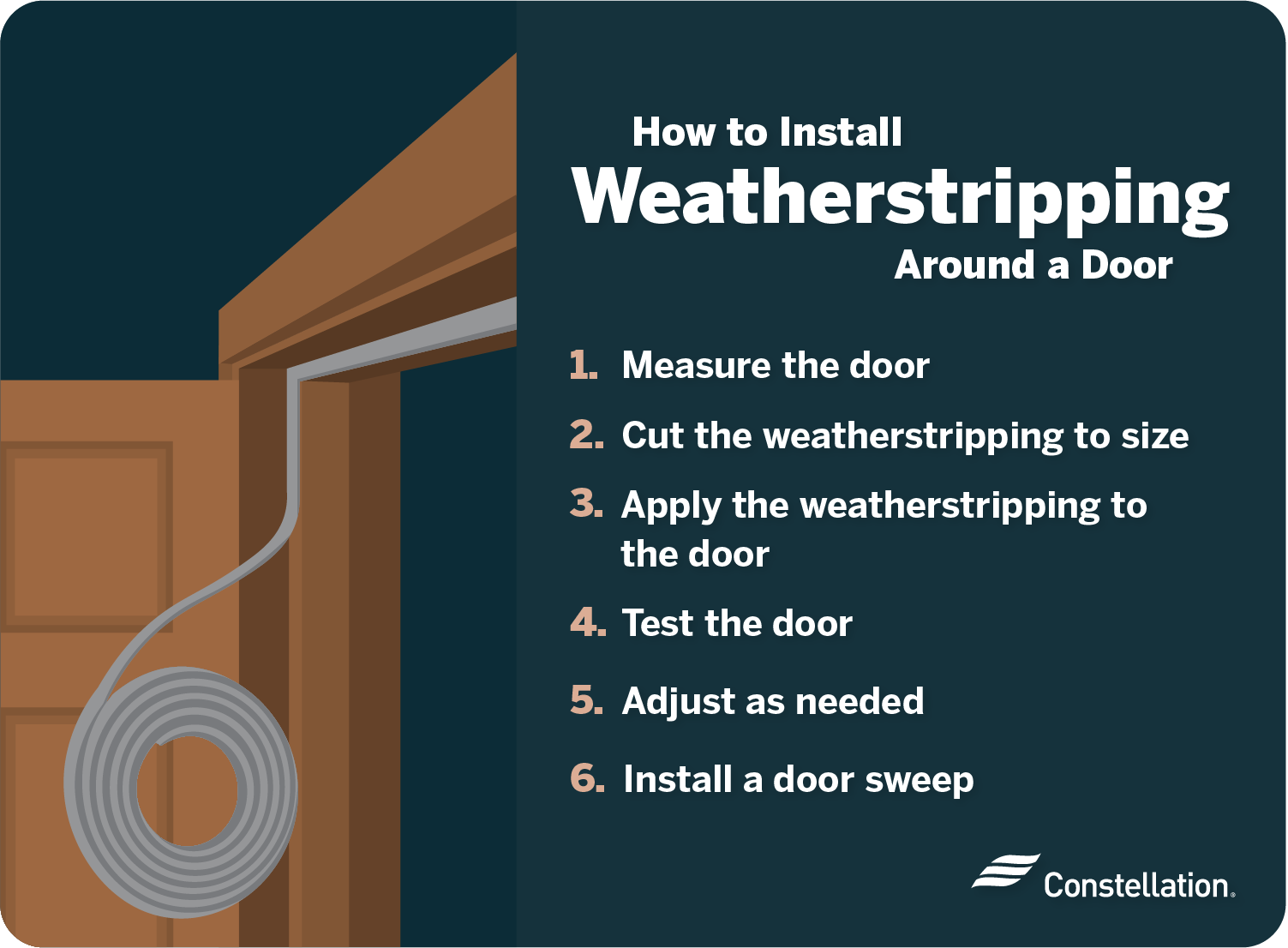
- Category:
Energy Efficiency -
Last updated:
November 17, 2022
How to Weatherstrip a Door the Right Way and Seal Door Gaps
Learn how to install door weatherstripping and you will put an end to energy-wasting drafts. When you look for places to weatherize your home for winter energy savings, door weatherstripping is a great place to start. You may find air leaks around the house, however, doors are one of the most common culprits. The steps for how to seal door gaps are simple with the right tools and products.
Weatherstripping tools and materials
To install weatherstripping for doors, gather your tools and choose among the types of weatherstripping. The best weatherstripping for doors is designed specifically for this kind of high traffic opening.
Tools Required:
- Sponge and rags
- Ammonia or adhesive remover
- Tape measure
- Scissors
- Drill
- Screwdriver
- Caulk gun
Materials Required:
- Door sweep and screws
- Weatherstrip kit
- Caulk
How to install weatherstripping on your doors (step-by-step)

How to weatherstrip a door correctly is easier than you think. Thoroughly clean the area to ensure your new weatherstripping will stick. Installing different types of weatherstripping may vary in the details, however, these steps apply to all varieties.
Step 1: Measure the door
How much weatherstripping do you need? How can you cut the pieces in the right size? It comes down to measuring. You want to have enough weatherstripping to completely seal around your door without gaps that could leave you with a drafty doorway.
Step 2: Cut the weatherstripping to size
Cut the weatherstripping to nearly the exact dimensions of your doorway. Measure twice and make notes for accuracy. It is better for your strips to be just a little too long than too short. You can always trim the excess.
Step 3: Apply the weatherstripping to the door
Check the weather. The weatherstripping adhesive bonds better on a day without rain or fog when it is at least 50°F (10°C) outside.
Start at the top corner of the door opening and place your first piece of weatherstripping so it is flush against the door frame. Peel off the adhesive backing about a foot at a time and press it into place as you go. Line up each piece so that there are no gaps.
Step 4: Test the door
Open and close the door to make sure it doesn’t catch on the weatherstripping. You don’t want it to jam and damage it or for it to start peeling.
Step 5: Adjust as needed
Adjust the door weatherstripping if necessary. You may want to reinforce the adhesive by using tacks or staples. Try not to use the door for an hour or so to give the adhesive a chance to really set and stick.
Step 6: Install a door sweep
The last step in how to install door weatherstripping is adding a door sweep. It stops drafts, but still allows the door to swing freely. Most are made of metal with a rubber edge to make a good seal. They come in standard size so you don’t have to cut it to fit.
Temporarily tape the sweep so that it covers the gap at the bottom of your door, but doesn’t scrape when the door swings. Drill small pilot holes in each screw hole. Use a slightly smaller drill bit than the screw. Insert the screws from the center and work out from there.
How do you replace weatherstripping around a door?
Replacing old weatherstripping is similar to how to install door weatherstripping the first time.
- When it comes to how to replace weather stripping on a door, preparation is the most important step. Remove the old weatherstripping and adhesive. Repair any holes in the surface so that you have a clean, dry, flat surface for the new weatherstripping to properly adhere.
- Measure carefully so that you have enough new weatherstripping to complete the job. Cut each piece for a continuous strip along the top and each side of the door. You can trim off the extra.
- When in place, the door should fit tightly against the weatherstripping without being difficult to open.
For more information on how to seal a door, visit our blog post about weatherizing your home.
How do you replace weatherstripping on the bottom of a door?

- Old weatherstripping on the bottom of the door should be replaced with a door sweep. It is more durable and will provide better protection against drafts. Clean off the old adhesive and any staples or tacks so that you have a flat, clean surface for the door sweep.
- Tighten the hinges of your door and examine the threshold. The sweep should provide a seal along the bottom of the door. One way to seal door gaps is to caulk where the threshold meets the floor.
- Measure the length of the door and look for a sweep that fits. Most standard options save you from cutting to fit.
- Attach the sweep along the bottom of the door so that it covers the gap against your threshold without scraping when the door swings. Drill small pilot holes in each screw hole with a drill bit that is slightly smaller than the screws. Insert and tighten the screws, making sure the sweep stays level.
- Ensure that the door closes and opens easily, and adjust if needed.
Add sound proofing
Adding insulation does more than stop drafts, it stops some sound from entering your home. Increasing the peace and quiet inside your house is well worth the effort to learn how to install door weatherstripping.
FAQs about weatherstripping a door
Weatherstripping a door is reasonably simple, but you may still have some questions. H3: What’s the best weatherstripping for a door?
Picking the right weatherstripping is half the battle. The kind of door, how much traffic it gets and your budget will guide your choices for the best weatherstripping for doors in your house. You can learn more about your door weatherstripping options here.
Do door seals go on the inside or outside?
Protecting your weatherstripping from the weather helps it last longer and work better. Place it inside your door jamb for optimum performance. Don’t place weatherstripping directly on your door. In addition to looking bad, it will not last as long and will suffer more wear and tear.
How often should you replace door weather stripping?
How long weatherstripping lasts depends on the type. If it is exposed to the elements, it will break down faster. The traffic through your door will also have an effect. Opening and closing a door often adds wear and tear. Expect five years of life, but inspect it often to know when to replace it.
Start saving on energy by sealing door gaps
Save energy by sealing door gaps. Of all the home energy saving things you can do, it is one of the easiest and least expensive.




